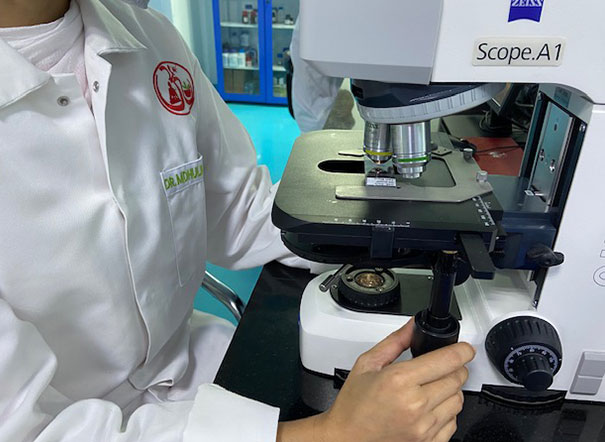In-Vivo Biology
In-Vivo Biology
The In-Vivo Biology department houses a state of the art laboratory animal facility based on clean and dirty corridor concept. Further, the facility is equipped with an airflow system that ensures the supply of clean, HEPA filtered air at specific temperatures and humidity to the animals housed within a room and exhausts all the contaminated air. This is facilitated by the existence of a positive differential pressure maintained between the clean corridor and the animal rooms.
The laboratory animal facility comprises of quarantine, holding, experimental, formulation, necropsy, animal food and bedding material storage rooms and a dedicated washing area with steam sterilizers. The facility is registered for experiments on animals (Registration number: 1964/PO/Rc/S/17/CPCSEA) under the Committee for the Purpose of Control and Supervision of Experiments on Animals (CPCSEA), Ministry of Fisheries, Animal Husbandry & Dairying, Government of India, New Delhi.

Animal experimentation is conducted under the guidance of the Institutional Animal Ethics Committee (IAEC) of Patanjali Research Institute with a license to work on small experimental animals such as mice, rats, rabbits, hamsters and guinea pigs.
The laboratory animal facility is equipped with individually ventilated cages (IVCs) and cage change stations for handling specific pathogen free as well as immunocompromised animals. Further, it possesses well-equipped pharmacology, histopathology and clinical chemistry laboratories. A full time veterinarian along with dedicated scientists and trained animal house technicians are available to provide care to the animals. The facility is under electronic surveillance (CCTV system) and controlled access system for authorized persons, in order to minimize the risk of infection to the animals. Furthermore, the entry to the clean corridor is equipped with an air shower to minimise particulate contamination.
Our highly qualified, experienced scientific team is currently focused in the therapeutic areas of metabolism, inflammation, respiration, nephrology, pain, autoimmunity, hepato-gastroenterology, thyroid, central nervous system, cardiovascular system, wound healing, bone metabolism and thrombocytopenia. So far, we have successfully tested more than 100 Ayurvedic test articles for these therapeutic areas. The following animal models have been standardized in-house and have been employed for screening of classical as well as novel Ayurvedic formulations:
- Streptozotocin-induced type I diabetes in rats
- Alloxan-induced type I diabetes in rabbits
- Streptozotocin and high fat died-induced type II diabetes in rats
- Triton-X induced hyperlipidemia in rats
- Collagen antibody-induced arthritis in rats
- Complete Freund’s adjuvant-induced arthritis in rats
- Monosodium iodoacetate-induced osteoarthritis in rats
- Dextran sodium sulfate-induced colitis in mice
- TPA-induced psoriasis-like lesions in mice
- Imiquimod induced psoriasis in mice
- Carrageenan induced paw edema in rats
- Paclitaxel-induced neuropathic pain in mice
- Chronic construction injury-induced neuropathic pain in rats
- Formalin induced writhing in mice
- Ovalbumin-induced allergic airway inflammation in mice
- House dust mite-induced airway hyperresponsiveness, airway inflammation and airway remodeling in mice
- House dust mite and Complete Freund’s adjuvant-induced mixed granulocytic airway inflammation in mice
- Cigarette smoke extract-induced pulmonary inflammation in mice
- Lipopolysaccharide-induced acute lung injury in rats
- Ethylene glycol-induced nephrolithiasis in rats
- Pylorus ligation-induced gastric ulceration in rats
- Carbon tetrachloride induced hepatotoxicity in rats
- Thioacetamide-induced hepatotoxicity in rats
- Methionine and choline deficient diet-induced non-alcoholic steatohepatitis in mice
- Aminotriazole-induced hypothyroidism in rats
- Deoxycorticosterone-induced hypertension in rats
- Scopolamine-induced memory impairment in mice
- Chronic unpredictable mild stress-induced depression in rats
- MPTP-induced Parkinson’s disease in mice
- Cyclophosphamide induced thrombocytopenia in mice
- Phenylhydrazine induced hemolytic anemia in rats
- Ovariectomy-induced osteoporosis in rats
- Acute and Subacute toxicity studies in rats in accordance with OECD guidelines
The department is equipped with the following instruments:
- In-Vivo Imaging System (IVIS Spectrum)
- flexiVent
- Electronic von Frey aesthesiometer
- Pressure application measurement apparatus
- Hot and Cold plate
- Tail flick apparatus
- Randall Sellito apparatus
- Rota Rod
- Non-invasive blood pressure apparatus
- Stereotaxic apparatus
- Elevated plus maze
- Actimeter
- Morris water maze
- Hematology analyser
- Clinical chemistry analysers
- Urinalyser
- Coagulation analyser
- Automated slide stainer
- Tissue processor
- Embedding station
- Microtome
- Deep freezers (-40ï‚°C and -80ï‚°C)

